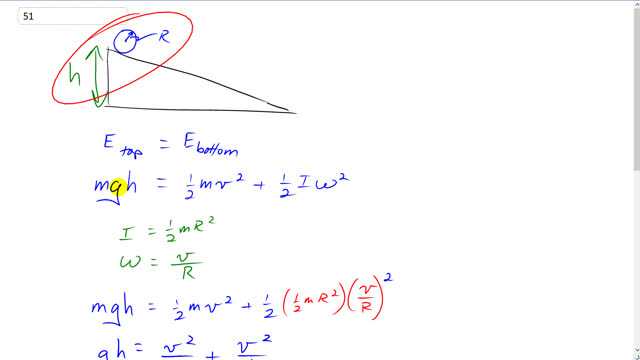
Calculate the translational speed of a cylinder when it reaches the foot of an incline 7.20 m high. Assume it starts from rest and rolls without slipping.

In order to watch this solution you need to have a subscription.
This is Giancoli Answers with Mr. Dychko. The total potential and kinetic energy is conserved throughout this trip down the ramp and so at the top, there's only potential energy, mgh, and at the bottom, there's only kinetic energy because we take the bottom to be our reference level so it has no height there, h would be zero at the bottom and so this is all kinetic energy— both translational kinetic energy and rotational kinetic energy. So this term here is what makes this question different from when we were doing chapter 3 say or even chapter 6 I guess when at the bottom, we would have all of the energy turn into this when we have something sliding down a ramp with no friction for example but now we have this other thing that the energy gets into converted into, it gets converted into this rotational kinetic energy as well as the translational kinetic energy. So we'll express this moment of inertia I as one-half m times radius squared because that's the formula for a cylinder and then we know that the angular velocity is the translational velocity divided by the radius of the object and then we'll substitute for each of those copying this formula right here down below by making substitutions in red for moment of inertia and angular velocity. And then we see that there's some nice handy things that happen: this R squared here on the bottom gets canceled with this one and m is a common factor for all terms and so we can divide every term by that as well and we have gh equals v squared over 2 plus v squared over 4 and then multiply everything by 4 to get rid of these denominators and we get 4gh equals 2v squared plus v squared so that makes 3v squared equals 4gh, divide both sides by 3 and then take the square root of both sides and in simplified form that would be 2 taken out of the square root times square root of gh over 3 and that's 2 times square root 9.8 times 7.2 meters divided by 3 which is about 9.70 meters per second will be the translational velocity at the bottom of the ramp and interestingly, this depends on neither the mass of the cylinder nor its radius.